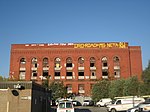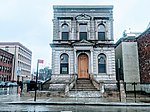Interference Archive
2011 establishments in New York CityArchives in the United StatesArt museums and galleries in BrooklynDIY cultureGowanus, Brooklyn ... and 2 more
Libraries in BrooklynSocial movements in the United States

Interference Archive is a volunteer-run library, gallery, and archive of historical materials related to social and political activism and movements. It is located in the Park Slope neighborhood of Brooklyn, New York City, at 314 7th St, Brooklyn, NY 11215. The mission of the organization is "to explore the relationship between cultural production and social movements."
Excerpt from the Wikipedia article Interference Archive (License: CC BY-SA 3.0, Authors, Images).Interference Archive
8th Street, New York Brooklyn
Geographical coordinates (GPS) Address Nearby Places Show on map
Geographical coordinates (GPS)
| Latitude | Longitude |
|---|---|
| N 40.672487 ° | E -73.991402 ° |
Address
8th Street 134
11215 New York, Brooklyn
New York, United States
Open on Google Maps






